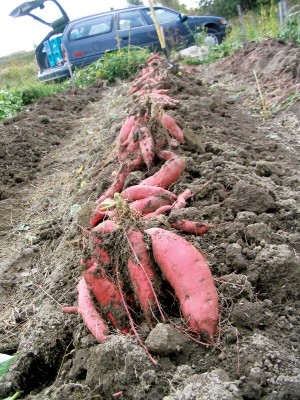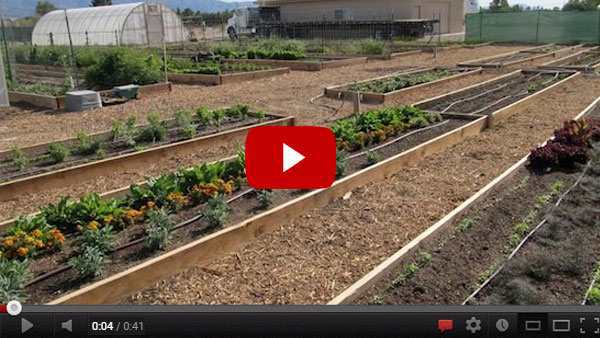Grow Sweet Potatoes
An ideal staple crop for those seeking to meet most of their food needs with homegrown produce would be nutrient-dense, offer high yields, and have excellent flavor and storage qualities. A crop that fits this bill perfectly? The sweet potato.
Sweet potatoes are more nutritious and store better than any other root crop — they’re easy for home gardeners to keep for a full year. And while many people think of them as a Southern crop, you can in fact easily grow sweet potatoes in northern climates.
Unforgettable Flavor
I’ve been growing (in Canada!) and learning about sweet potatoes since the mid-1980s, when my friend, Suzanne Mason, who lives in South Carolina in the winter, brought me a half-bushel of cured sweet potatoes. They were incredibly sweet and delicious. I thought I knew sweet potatoes, but I never imagined they could be this good!
I wondered whether Suzanne’s grower in South Carolina had a secret. There must be a secret, or I wouldn’t have gone my entire life without coming across this superb flavor.
I now know that the matter is a bit more complicated than one simple secret. There are five facts about sweet potatoes that may seem like they’re secrets — because a sweet potato rarely makes the trip from field to dinner table without one or more of these facts being ignored — but none of them is optional if you want truly great sweet potatoes. Each ’tater truth by itself, if neglected, is sufficient to reduce flavor.
Five Facts for Fabulous Sweet Potatoes
1. Sweet potatoes are alive and they breathe. Never store them in a sealed plastic bag — the gases from their respiration will build up and the potatoes will eventually poison themselves. Paper bags or boxes are good for storage, or throw plastic tarps loosely over your crates of sweet potatoes. In fact, as long as you take care with the curing process (see fact No. 4) and store them at about 60 degrees Fahrenheit, you don’t need to cover sweet potatoes at all during storage (unless rodents could access them).
2. Do not toss or drop sweet potatoes into storage containers. When you dig them, they’ll be firm and appear indestructible — they’re not! A drop that is sufficient to crack an egg is sufficient to produce a tiny bruise on a sweet potato. After a few months in storage, that tiny bruise can turn into a large, rotten spot, which often ruins the entire potato.
3. Sweet potatoes are tropical plants and the storage roots (tubers) start to “shiver” at 50 degrees. Your refrigerator is probably set to a few degrees above freezing, which is a good temperature for carrots, apples and most juices, but not so good for tomatoes, bananas and especially sweet potatoes. At the cool temperature of your refrigerator (or in a supermarket cold room, where fresh fruit and vegetables, including sweet potatoes, are stored), a sweet potato will “shiver,” and in less than a day, the once living, breathing, healthy sweet potato will turn into a corpse. It will remain a good-looking corpse for a few days, but will then develop pockmarks and a hard core. The official name for this cause of death is “chilling injury,” and it’s thought to be the result of a change in metabolism that causes cell walls to no longer have proper control of what comes in and goes out.
4. Sweet potatoes need to be cured, starting on harvest day. To cure them, keep your sweet potatoes at 85 to 90 degrees for five days. During this time, the sweet potato will grow a second skin, which is an incredibly effective seal. After curing, you can leave a sweet potato on the kitchen counter for several months without noticeable moisture loss. Without curing, the sweet potato will only last a month or two in storage. Curing also initiates flavor development.
Providing proper curing conditions for five days may require some planning in advance. Think creatively about available spaces — a large closet with a 100-watt light bulb, a bathroom with an independent thermostat, or even a spare bedroom with a small electric heater. Keep your curing space at 80 to 90 percent humidity for best results.
5. A newly dug sweet potato is virtually tasteless — it’s definitely not a treat! A sweet potato doesn’t reach its flavor potential until it has been cured and then stored for a few months. Eat sweet potatoes when they’re new if you must, but don’t judge them until after New Year’s Day.
Hot Potatoes!
Sweet potato plants are, in most respects, undemanding. They prefer light, sandy soil, but will tolerate heavy clay. They respond well to rich soil, but can do surprisingly well in soil of low fertility. Sweet potatoes do best in sunny locations with regular rain or irrigation, but will mark time during a period of drought and then carry on when the rain returns. Excessive rain and flooding will slow them down, but won’t necessarily harm them.
Growing temperature is the only environmental factor that can’t be ignored — sweet potatoes like it hot! There are several critical temperatures for sweet potatoes, and I keep these temperatures straight by likening them to an old-fashioned report card. Because of chilling injury, a soil temperature below 50 degrees (50 percent) is a failure, and 50 to 55 degrees is dangerously close to the failure mark. Sixty percent, give or take a few percentage points, is an acceptable mark for a student not planning for higher education — and at about 60 degrees, the metabolism of the sweet potato slows to near zero, meaning it won’t grow. Temperatures above 70 degrees, as with grades, are conditions that allow growth: slow at 70 degrees, good at 80 degrees, very good at 90 degrees and excellent at 100 degrees.
Southern growers can wait until the soil warms up and still have time to grow a good crop of sweet potatoes. In Canada and the northern United States, June is the month with the longest, sunniest days, and although it’s an excellent growing month for crops that do well in 60-degree soil, it’s not so good for sweet potatoes — unless you get proactive.
Warm ’Em Up
In order to grow sweet potatoes in the North (Zones 3 to 5), you can’t wait until July — you must make full use of June by warming up the soil.
The simplest and most effective way to warm the soil is to cover it with a sheet of clear plastic. If you were thinking black plastic when I said soil warming, you may have skipped right over the word “clear.” Yes, clear plastic. About 90 percent of the energy from the sun goes through clear plastic, where it’s then absorbed by the soil and trapped there by the greenhouse effect. On the other hand, when opaque plastic gets hot, only a fraction of the heat is transmitted to the soil, and the rest just radiates back into the air above.
Look for clear builder’s plastic (used as a vapor barrier) that’s about 8 1/2 feet wide. Cutting it down the middle will make two sheets, each just more than 4 feet wide. This is an ideal width for slightly raised, 2-foot-wide beds. Lay the plastic on the bed so that 1 foot remains on each side, then pull the plastic snug and bury the 1-foot edges down the length of the bed. It’s important that the plastic, like the bottom sheet on a bed, be pulled taut and tucked in. Placing heavy objects on the edge of the plastic here and there down the length of the row is good for a start, but it won’t be sufficient. If you only loosely apply the plastic, the moisture under it will turn into hot vapor that will then flow out from under the plastic, causing the soil to lose heat and moisture.
If you’re using clear plastic to grow sweet potatoes in a northern climate, you’ll have a couple extra steps when it’s time to plant your slips: Cut an 8-inch slit in the plastic, and press the soil down to make a shallow, bowl-shaped depression (1 foot in diameter) centered on the slit. Plant the slip through the slit, and water well. Place sand or fine gravel around the plant to cover the slit and to weigh the plastic down into the depression in the bed. This will seal the slit, and the depression will ensure that, when it rains, water will run into the bed at the base of each plant.
Some gardeners cite weeds as a reason for not using clear plastic mulch. If weeds survive under your clear plastic, though, it’s a sign you did something wrong. Plastic fit snugly on the bed with no vents to allow hot air to escape will create an environment too hot and too confined for weeds.
Builder’s plastic comes in heavy, medium and light grades. Light is the best for warming up soil because it lies tighter on the bed. Some gardeners are uneasy about using plastic in the garden because it’s manufactured from a nonrenewable resource. However, in my opinion, capturing the heat of the sun under clear plastic is one of the most worthwhile uses we can make of that resource.
Harvest Time
While for most growers the main event comes in fall, you can cut and enjoy spicy, tender sweet potato greens during summer. My neighbor from China likes to grow sweet potatoes mainly for their vine tips. Just be aware that excessive harvesting of the greens will delay tuber growth and decrease yields.
When fall arrives, your sweet potatoes will not “mature” — they will just slow down and eventually stop growing when the soil temperature drops below 55 degrees or the vines get hit by frost. In either case, it’s time to dig your sweet potatoes!
A broadfork is a great tool for digging potatoes. After digging, gently wash your tubers on the same day. I wash using just the spray from a hose, but you can also use a pail of water, wiping lightly with a rag or soft brush. Washing immediately after you harvest has the benefit of leaving garden soil in the garden, where it belongs (soil has sand in it, which will eventually plug your drains). Also, clean sweet potatoes are nicer to handle and easier to inspect. Next, cure them, store them, and wait a month or more for them to turn into the best sweet potatoes you’ve ever tasted.
Sweet Potato Varieties
Over the years, I’ve grown about 40 sweet potato varieties. I’ve found significant differences in color, texture, growth habits, yield and time to harvest. But for me, the most important consideration is flavor, and I’ve found no variety that is far superior to any other. Flavor depends much more on curing, storage and method of cooking than on the variety you grow.
‘Beauregard,’ the main commercial variety, is a good producer, has good flavor, stores well, has compact vines, and its tubers tend to grow close to the stem.
If you want to try something different, consider growing ‘Toka Toka Gold,’ a yellow-fleshed variety that’s drier, smoother, denser and milder than most. It comes from New Zealand, where it’s sometimes referred to as ‘Golden Kumara.’
‘Georgia Jet’ is the most reliable variety for northern climates. Unfortunately, two quite different varieties are using that name. I think of them as the Real ‘Georgia Jet’ and the Impostor. The Real ‘Georgia Jet’ is the main commercial variety in Israel and the most popular variety among gardeners in Canada. The Impostor is widely grown in the United States, and while its flavor is excellent, the variety has a reputation for poor yields and cracking.
If you thought you’d been growing the Real ‘Georgia Jet’ but are now in doubt, telling the difference is easy: . If your ‘Georgia Jet’ did blossom, please write to us at [email protected] and tell us the source of your stock. We’ll publish the information in an upcoming issue.
Simple Sweet Potato Slips
Unlike the standard potato, which is grown from tubers, sweet potato crops are started from “slips.” To create a slip, a sweet potato tuber is planted indoors or in a greenhouse — or stood up in a glass of water — to produce sprouts. The resulting sprouts are what you’ll plant outdoors, not the tuber. A slip can be a sprout directly from the sweet potato, or it can be a vine cutting from an already established sweet potato plant. You can order slips from mail-order suppliers, buy them at a garden center or grow your own.
To grow your own sweet potato slips from tubers, first place the tubers in water in early spring. When the sprouts form, break them off and plant them directly in the garden. Roots will form quickly. If you’d like to use a vine cutting, cut any sections from a long vine into 1-foot lengths, stand them up in a glass of water for two days to initiate rooting, and then plant them 1 to 2 feet apart with half their length below ground, half above. Soak your slips with warm water immediately after planting them.
Discover how to survive: Most complete survival tactics, tips, skills and ideas like how to make pemmican, snow shoes, knives, soap, beer, smoke houses, bullets, survival bread, water wheels, herbal poultices, Indian round houses, root cellars, primitive navigation, and much more at: The Lost Ways
The Lost Ways is a far-reaching book with chapters ranging from simple things like making tasty bark-bread-like people did when there was no food-to building a traditional backyard smokehouse… and many, many, many more!
Here’s just a glimpse of what you’ll find in The Lost Ways:
From Ruff Simons, an old west history expert and former deputy, you’ll learn the techniques and methods used by the wise sheriffs from the frontiers to defend an entire village despite being outnumbered and outgunned by gangs of robbers and bandits, and how you can use their wisdom to defend your home against looters when you’ll be surrounded.
Native American ERIK BAINBRIDGE – who took part in the reconstruction of the native village of Kule Loklo in California, will show you how Native Americans build the subterranean roundhouse, an underground house that today will serve you as a storm shelter, a perfectly camouflaged hideout, or a bunker. It can easily shelter three to four families, so how will you feel if, when all hell breaks loose, you’ll be able to call all your loved ones and offer them guidance and shelter? Besides that, the subterranean roundhouse makes an awesome root cellar where you can keep all your food and water reserves year-round.
From Shannon Azares you’ll learn how sailors from the XVII century preserved water in their ships for months on end, even years and how you can use this method to preserve clean water for your family cost-free.
Mike Searson – who is a Firearm and Old West history expert – will show you what to do when there is no more ammo to be had, how people who wandered the West managed to hunt eight deer with six bullets, and why their supply of ammo never ran out. Remember the panic buying in the first half of 2013? That was nothing compared to what’s going to precede the collapse.
From Susan Morrow, an ex-science teacher and chemist, you’ll master “The Art of Poultice.” She says, “If you really explore the ingredients from which our forefathers made poultices, you’ll be totally surprised by the similarities with modern medicines.” Well…how would you feel in a crisis to be the only one from the group knowledgeable about this lost skill? When there are no more antibiotics, people will turn to you to save their ill children’s lives.
If you liked our video tutorial on how to make Pemmican, then you’ll love this: I will show you how to make another superfood that our troops were using in the Independence war, and even George Washington ate on several occasions. This food never goes bad. And I’m not talking about honey or vinegar. I’m talking about real food! The awesome part is that you can make this food in just 10 minutes and I’m pretty sure that you already have the ingredients in your house right now.
Really, this is all just a peek.
The Lost Ways is a far-reaching book with chapters ranging from simple things like making tasty bark-bread-like people did when there was no food-to building a traditional backyard smokehouse… and many, many, many more!
And believe it or not, this is not all…
Table Of Contents:
The Most Important Thing
Making Your Own Beverages: Beer to Stronger Stuff
Ginger Beer: Making Soda the Old Fashioned Way
How North American Indians and Early Pioneers Made Pemmican
Spycraft: Military Correspondence During The 1700’s to 1900’s
Wild West Guns for SHTF and a Guide to Rolling Your Own Ammo
How Our Forefathers Built Their Sawmills, Grain Mills,and Stamping Mills
How Our Ancestors Made Herbal Poultice to Heal Their Wounds
What Our Ancestors Were Foraging For? or How to Wildcraft Your Table
How Our Ancestors Navigated Without Using a GPS System
How Our Forefathers Made Knives
How Our Forefathers Made Snow shoes for Survival
How North California Native Americans Built Their Semi-subterranean Roundhouses
Our Ancestors’Guide to Root Cellars
Good Old Fashioned Cooking on an Open Flame
Learning from Our Ancestors How to Preserve Water
Learning from Our Ancestors How to Take Care of Our Hygiene When There Isn’t Anything to Buy
How and Why I Prefer to Make Soap with Modern Ingredients
Temporarily Installing a Wood-Burning Stove during Emergencies
Making Traditional and Survival Bark Bread…….
Trapping in Winter for Beaver and Muskrat Just like Our Forefathers Did
How to Make a Smokehouse and Smoke Fish
Survival Lessons From The Donner Party
Books can be your best pre-collapse investment.
The Lost Ways (Learn the long forgotten secrets that helped our forefathers survive famines,wars,economic crisis and anything else life threw at them)
Survival MD (Best Post Collapse First Aid Survival Guide Ever)
Conquering the coming collapse (Financial advice and preparedness )
Liberty Generator (Build and make your own energy source)
Backyard Liberty (Easy and cheap DIY Aquaponic system to grow your organic and living food bank)
Bullet Proof Home (A Prepper’s Guide in Safeguarding a Home )
Family Self Defense (Best Self Defense Strategies For You And Your Family)
Survive Any Crisis (Best Items To Hoard For A Long Term Crisis)
Survive The End Days (Biggest Cover Up Of Our President)
Drought USA (Discover The Amazing Device That Turns Air Into Water)
SOURCE : motherearthnews.com
Ken Allan, author of Sweet Potatoes for the Home Garden, has been growing vegetables in Canada for 37 years. For a long time, prime real estate in his garden went to the vegetables that are clearly better than their commercial equivalents, such as shell peas and tomatoes. That is, until Ken realized he could grow sweet potatoes in the North!





Thanks for this info! Sweet potatoes will be on my list in 2014!